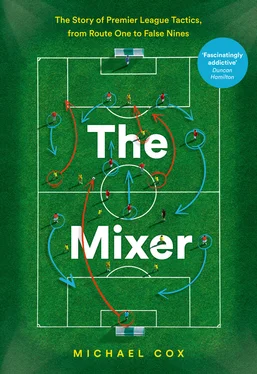More than anything else, however, Newcastle’s problem was their overall lack of cohesion, surely due to omitting any collective work on the training ground. Keegan’s threw together talented individuals and let them run free, which largely worked with a simple, old-fashioned 4–4–2 that everyone knew how to play. But this laissez-faire style proved problematic when Keegan suddenly switched shape, when he signed a different type of centre-forward and a different type of deep midfielder. Newcastle simply didn’t have any tactics; their approach was a consequence of the 11 players Keegan assembled on any particular day.
But while Newcastle ultimately fell short of winning the Premier League, it was unquestionably a glorious failure; the players remain heroes in the city, the team still admired across the country. Keegan’s achievement in taking Newcastle from the second tier to the brink of the title shouldn’t be underestimated, and while naivety may have cost Newcastle the title, the most pertinent story is that they came so close with such basic tactics, highlighting the primitive approach of most Premier League sides at this point.
The title was presented in the north-east – but at Middlesbrough, where Manchester United ended the season with a 3–0 victory. Keegan was magnanimous in defeat, immediately congratulating Manchester United and predicting they would be ‘fantastic representatives of the Premier League in the Champions League’ the following season. It recalled the way he’d referred to Asprilla, upon the Colombian’s arrival, as ‘a real asset to the Premier League – and Newcastle United, I hope’. Perhaps it was just semantics, but it’s difficult to imagine Ferguson, who cultivated an ‘us against the world’ approach, caring about the benefits to the league as a whole.
Newcastle responded to their failure in dramatic fashion, breaking the world transfer record to sign hometown boy Shearer from Blackburn. Keegan lasted just half of the following campaign before suddenly resigning, to be replaced by, inevitably, Dalglish. With Batty, Shearer and Dalglish, it was clear Newcastle were trying to be Blackburn – but tactically, the Premier League was already moving in a different direction.
Part Two
Technical Progress
4
‘Cantona’s supporters loved him, and so did the media. He was this foreign fella, different. Everyone wanted one like him, but it didn’t mean players like that grew on trees.’
Roy Evans
As Eric Cantona’s influence ensured Manchester United became the Premier League’s dominant force, other clubs desperately searched for their Cantona equivalent. A wave of talented, mercurial but often inconsistent number 10s joined the Premier League during the mid-1990s, with mixed success. England wasn’t producing players in that mould, so clubs looked abroad – often to relatively obscure footballing nations. Supporters of unglamorous, mid-table Premier League sides could now get excited by exotic, mysterious foreign deep-lying forwards whose presence was meant to inspire more aesthetically pleasing football.
Ipswich Town, for example, had Bulgarian Boncho Genchev, who opened his goalscoring account with a wonderful bicycle kick against Blackburn. He positioned himself between the lines to encourage passing football, but struggled to exert a consistent impact upon Premier League games. After a brief spell back home, he ended his career with a couple of spells at non-league Hendon, taking a break in between to run a short-lived Bulgarian café in Kensington called ‘Strikers’. Genchev himself wasn’t actually a striker, of course, although he was presumably comfortable in the serving role.
Southampton found the diminutive, extraordinarily gifted Israeli Eyal Berkovic, who featured decisively in the Saints’ famous 6–3 victory over Manchester United in 1996, his second league start. Berkovic enjoyed a successful Premier League career, although he is probably most famous for being booted in the head during a West Ham training session by teammate John Hartson.
Derby County signed Aljoša Asanović, a wonderful left-footed creator who played a significant part in Croatia’s journey to the Euro 96 quarter-finals and the 1998 World Cup semi-finals, and who is quite possibly the most underrated Premier League player. Unsurprisingly, he insisted on taking the number 10 shirt. Coventry City signed Moroccan Mustapha Hadji, a direct dribbler with a fine passing range, and he also took number 10. At West Ham, Harry Redknapp signed the Premier League’s first two Portuguese players – first Dani, then Paulo Futre. To Futre’s disgust, he wasn’t handed the number 10 shirt.
Ahead of his first game against Arsenal, West Ham’s kitman Eddie Gillam handed Futre the number 16 shirt, and promptly had it thrown back in his face. Not understanding that the Premier League had switched to permanent squad numbers that were consistent throughout the season and that number 10 had already been allocated to John Moncur, Futre shouted at Redknapp, ‘Futre 10, not 16! Eusebio 10! Maradona 10! Pelé 10! Futre 10! Not fucking 16!’ Redknapp told Futre to either wear the number 16 shirt or go home. So Futre went home. He later insisted the number 10 shirt was written into his contract, and when Redknapp pretended West Ham’s club shop had shifted so many shirts with Futre’s name and ‘16’ on the back that they couldn’t change it, Futre offered to refund any disappointed supporters up to a total cost of £100,000. Eventually West Ham sought permission from the Premier League for Moncur to change numbers, allowing Futre to wear 10; he thanked Moncur by allowing him a fortnight’s stay in his holiday villa on the Algarve. It’s surprising something similar didn’t happen at Sheffield Wednesday a couple of years later – two brilliant Italians, Benito Carbone and Paolo Di Canio, had serious claims to the number 10 shirt, but were forced to wear 8 and 11 respectively, with their favoured number taken by the somewhat less spectacular Andy Booth.
During this period, a relatively limited number of games were broadcast live on TV, while Match of the Day showed extended highlights from only a couple of big matches, screening just goals and major incidents from others. These players’ subtle, constant influence upon matches was therefore not overwhelmingly obvious to the majority of supporters, so they needed to provide concise summaries of their quality with outstanding individual moments.
Between November 1996 and August 1997 the BBC’s Goal of the Month competition was won by Dennis Bergkamp, Eric Cantona, Trevor Sinclair, Gianfranco Zola, Juninho, Zola again, Juninho again, then Bergkamp again – who, ludicrously, finished 1st, 2nd and 3rd that month. Sinclair’s famous bicycle kick aside, the Premier League’s greatest moments were being provided almost exclusively by four magical foreign playmakers: Cantona, Bergkamp, Zola and Juninho. These players fundamentally changed their clubs’ footballing style, but required their sides to be built entirely around them. This proved problematic. Depending upon a newcomer to English football was risky, especially when foreign imports were still a relatively recent phenomenon and clubs did extremely little to help them settle.
If Cantona was the trailblazer, Bergkamp and Zola followed closely behind in his slipstream. They weren’t, however, joining title challengers; Arsenal had finished in the bottom half of the Premier League immediately before signing Bergkamp in the summer of 1995, as had Chelsea just before their purchase of Zola the following year. Like Cantona, both players had an immediately positive effect on their teams, and the fact that Manchester United, Arsenal and Chelsea have been the three most successful clubs in the Premier League era can, in part, be traced back to the arrival of these three brilliant deep-lying forwards.
Читать дальше












